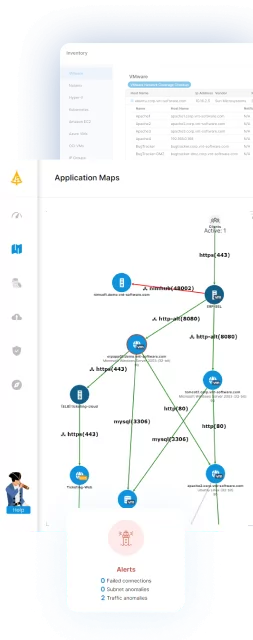Network behavior anomaly detection (NBAD) is a security technology that monitors network traffic to identify patterns that deviate from established norms. Unlike traditional security solutions relying on signatures of known threats, NBAD focuses on the behavioral characteristics of network activity, such as traffic volume, protocol usage, and connection patterns.
By detecting unexpected deviations, NBAD systems can highlight potentially malicious actions even when they use novel methods or exploit unknown vulnerabilities.
This approach enables earlier detection of sophisticated threats, including zero-day attacks and persistent threats, which may evade signature-based defenses. NBAD solutions typically analyze large volumes of data in real time, using statistical, machine learning, or heuristic algorithms.
Table of Contents
ToggleThe Importance of Network Behavior Anomaly Detection
Network behavior anomaly detection aids in strengthening cybersecurity and improving network visibility across an organization. It allows different teams to proactively identify threats, optimize system performance, and respond quickly to anomalies:
- For security leadership, NBAD collects traffic data from sources like routers and switches using formats such as NetFlow and IPFIX. This enables detection of malicious activities, including botnets, data exfiltration, and insider threats. NBAD also improves overall network operations by flagging unusual behavior or operational issues early.
- Development teams benefit from NBAD by gaining visibility into application-level performance issues. By correlating long-term behavioral data with real-time network metrics, NBAD helps detect performance degradation before users are impacted. This shifts application monitoring from reactive to proactive, reducing downtime and improving user satisfaction.
- Product and customer experience teams use NBAD to monitor how new application versions behave in production. Any performance issues or unexpected behavior introduced during releases can be identified and addressed quickly, improving product reliability and customer trust.
- For security operations teams, NBAD shortens the time between anomaly detection and response. It provides continuous monitoring and real-time alerts for issues such as API failures, server outages, or suspicious traffic spikes, helping to prevent escalation into major incidents.
NBAD is also adaptable across industries. In eCommerce, it helps detect anomalies like traffic spikes or pricing errors. In telecom, it monitors metrics like jitter and latency. Adtech firms use it to track large, real-time transactions, while gaming and finance sectors rely on it to ensure system integrity and secure operations under high-load conditions.
Core Components of NBAD Systems
Data Collection
NBAD systems rely on extensive and continuous data collection to understand what constitutes normal network behavior. This involves capturing metadata from network traffic, including source and destination addresses, port numbers, application types, data volumes, and timestamps.
Sensors, probes, or taps are typically deployed at key network points, aggregating data from multiple segments to maximize visibility. Comprehensive data collection is essential to ensure that subtle anomalies don’t go unnoticed in seldom-monitored parts of the network. The gathered data must be granular, including both high-level flow information and deeper packet inspection.
Baseline Establishment
Once data is collected, NBAD systems need to determine what constitutes “normal” behavior for the network. This involves analyzing historical network data to establish reference points for acceptable traffic volumes, flow patterns, and application usage at different times and locations. Baselines can be dynamic, adjusting to cyclical changes such as workday peaks.
Accurate baselines are crucial since the effectiveness of anomaly detection depends on correctly identifying genuine deviations as opposed to normal fluctuations. NBAD systems may use unsupervised machine learning algorithms or statistical methods to automatically adjust their baselines over time.
Anomaly Detection Engine
The anomaly detection engine is the analytical core of NBAD systems. It continuously compares real-time network activity against established baselines to identify deviations that could indicate malicious or unauthorized behavior. Detection engines employ statistical analysis, rule-based heuristics, or machine learning models to classify observed patterns as normal or anomalous.
These analytical techniques help uncover patterns that may not be evident through manual inspection or basic signature matching. A strong detection engine must account for the variability within legitimate network usage. It should distinguish true threats from benign anomalies, such as sudden but harmless spikes in traffic due to business events.
Alerting Mechanism
Upon detecting an anomaly, NBAD systems must communicate this information effectively through alerting mechanisms. Alerts need to be timely and informative, containing sufficient context—such as affected devices, timestamps, and the nature of the deviation—to guide immediate investigation.
Well-designed alerting helps avoid alert fatigue by prioritizing incidents based on severity and potential impact, filtering out non-critical events while escalating true threats. Integration with centralized logging and incident response platforms is essential for simplifying the investigative workflow.

Lanir specializes in founding new tech companies for Enterprise Software: Assemble and nurture a great team, Early stage funding to growth late stage, One design partner to hundreds of enterprise customers, MVP to Enterprise grade product, Low level kernel engineering to AI/ML and BigData, One advisory board to a long list of shareholders and board members of the worlds largest VCs
Tips from the Expert
In my experience, here are tips that can help you design and run highly effective network behavior anomaly detection (NBAD) systems:
- Use layered anomaly models for contextual accuracy: Combine global network baselines with micro-baselines for specific segments, devices, and user groups. This multi-granularity approach helps detect subtle anomalies (like insider threats) while reducing false positives from diverse usage patterns.
- Correlate anomalies across time and domains: Don’t analyze anomalies in isolation. Correlate them across time windows (e.g., repeated small data transfers at odd hours) and security domains (e.g., endpoint alerts + network anomalies) to uncover multi-stage attacks like lateral movement or data staging.
- Deploy deception techniques to enrich NBAD training: Use honeynets and decoy services to attract attackers and capture anomalous traffic. Feed this data into NBAD models to improve detection of real-world malicious patterns that are often missing from training datasets.
- Integrate encrypted traffic analysis (ETA): With rising TLS adoption, much network traffic is opaque. Incorporate ETA techniques (e.g., flow metadata, packet sizes, and timing analysis) to detect anomalies in encrypted sessions without breaking encryption.
- Prioritize east-west traffic monitoring: Most NBAD deployments focus on north-south traffic (external flows), but modern threats often spread internally. Ensure sensors monitor east-west traffic within the data center and cloud environments to detect lateral movement.
Types of Network Anomalies
NBAD systems are designed to detect a range of network anomalies, each of which may indicate a different class of threat or operational issue. These anomalies can be categorized based on their behavior patterns and impact on network performance or security.
Volume-based anomalies
These involve significant changes in data transfer volume. Examples include sudden surges in outbound traffic, which may indicate data exfiltration, or abnormal spikes in inbound traffic, which could be early signs of a distributed denial-of-service (DDoS) attack. Volume-based anomalies are typically easier to detect but can generate false positives during legitimate high-traffic periods.
Time-based anomalies
These focus on deviations from expected timing patterns. For instance, scheduled backups or software updates usually happen at predictable times. Traffic that mimics these patterns but occurs at irregular hours may indicate unauthorized activity. Time-based anomalies also help detect beaconing behavior, often used in command-and-control communications.
Protocol anomalies
These involve unusual usage or combinations of network protocols. NBAD systems may flag anomalies like the use of outdated or insecure protocols, unexpected port usage, or abnormal sequencing of protocol commands. Such deviations often signal misconfigured systems, unauthorized access attempts, or exploitation of protocol vulnerabilities.
Behavioral anomalies
These arise from changes in how devices, users, or applications interact on the network. Examples include a device suddenly communicating with external servers it never contacted before, or an employee accessing sensitive data outside their normal behavior pattern. These anomalies are often subtle and require baselines for accurate detection.
Topological anomalies
These involve unexpected shifts in communication paths or network topology. For example, a device routing traffic through an unrecognized gateway could indicate a man-in-the-middle attack or network misconfiguration. Topological changes can also be signs of lateral movement by an attacker.
Use Cases and Applications of Network Anomaly Detection
Here’s a look at some of the main contexts in which organizations use network behavior anomaly detection.
1. DDoS Detection, Protection, and Mitigation
NBAD systems are effective at detecting the onset of distributed denial of service (DDoS) attacks by identifying abnormal surges in traffic from multiple sources. Unlike static rule-based defenses, NBAD can recognize novel DDoS behaviors by comparing real-time network patterns to historical baselines.
Beyond initial detection, NBAD assists in differentiating between attack traffic and legitimate surges, such as marketing events or seasonal spikes, through ongoing context-aware analysis. Once a DDoS attack is confirmed, NBAD systems can trigger automated mitigation—rerouting or filtering malicious traffic dynamically without affecting regular users.
2. Intrusion Detection and Threat Hunting
NBAD augments traditional intrusion detection systems by surfacing subtle network behaviors that may indicate compromise, such as lateral movement, privilege escalation, or command-and-control communications.
By flagging activity that deviates from established baselines, NBAD enables security teams to identify emerging threats even when their signatures are unknown or obfuscated. This behavior-based approach is essential for uncovering targeted attacks and insider threats.
In threat hunting scenarios, NBAD provides context by mapping the timeline and scope of anomalous activities. Analysts can use these data points to trace attacker pathways, assess impact, and remove adversaries before critical assets are exposed.
Learn more in our detailed guide to AI intrusion detection (coming soon)
3. Network Performance and Reliability
NBAD is also instrumental in monitoring network health and ensuring reliable performance. Unexpected changes in traffic flows, protocol usage, or transmission rates can signal outages, misconfigurations, or degraded hardware. Early identification of such anomalies allows IT teams to resolve underlying issues before they cascade into widespread disruptions.
By continuously analyzing baseline performance metrics, NBAD systems help maintain consistent network availability and optimize resource allocation. Detecting anomalies that are not linked to malicious activity supports faster troubleshooting and reduces downtime. In highly regulated or mission-critical environments, this capability improves resilience.
4. Digital Forensics and Incident Response
During incident response, NBAD systems provide a detailed, time-stamped record of anomalous events leading up to and during a security incident. These logs enable digital forensic investigations by allowing analysts to reconstruct the sequence and nature of malicious activities.
NBAD also accelerates post-incident recovery by highlighting system weaknesses and attack vectors exploited by adversaries. Lessons learned from these insights inform ongoing security improvements, such as adjusting baselines, updating monitoring rules, or deploying additional controls. In regulated industries, the availability of granular forensic data aids in compliance reporting and legal proceedings.
Best Practices for Network Behavior Anomaly Detection Implementation
Organizations should consider these practices when implementing NBAD.
1. Continuously Monitor and Adjust Baselines
A static baseline quickly loses relevance as organizational usage patterns evolve. Continuous monitoring and adjustment are required to ensure that the detection of anomalies remains accurate in the face of shifting business practices, technology upgrades, or the introduction of new applications. Automated learning mechanisms can enable baseline adaptation, but periodic manual review is necessary for fine-tuning and reducing false positives.
Regular baseline updates allow NBAD systems to capture emerging legitimate behaviors, such as expanding remote work or the rollout of new cloud services. This proactive approach reduces unnecessary alerts while ensuring that genuine threats are not dismissed as normal activity. Effective baseline management is essential for reliable, actionable threat detection that adapts to both short- and long-term organizational changes.
2. Integrate NBAD With Existing Security Tools
NBAD delivers maximum value when integrated into a broader security ecosystem. Linking NBAD with security information and event management (SIEM) solutions, firewalls, endpoint detection, and automated response platforms simplifies incident correlation and triage. Integrated systems enable security teams to view anomalies within the context of other threat data, improving overall decision-making and accelerating containment efforts.
APIs and built-in connectors enable interoperability between NBAD and other security tools. Unified dashboards and automated playbooks enable rapid response to threats identified through NBAD workflows. Integration also supports compliance and audit initiatives by consolidating detection and response evidence across the IT environment.
Learn more in our detailed guide to AI security tools (coming soon)
3. Segment and Encrypt Sensitive Traffic
Network segmentation and encryption should be implemented alongside NBAD to restrict lateral movement and protect data integrity. By dividing the network into logical segments based on sensitivity or function, organizations can limit the spread of anomalies and improve detection accuracy.
NBAD systems paired with segmentation can detect unusual traffic attempting to traverse restricted boundaries. Encryption of sensitive data ensures that even if anomalous activity is detected, intercepted content is protected from eavesdropping. Secure communication channels further complicate attackers’ attempts to exfiltrate information or disrupt services undetected.
4. Conduct Frequent Model Retraining
Machine learning-based NBAD systems require recurring retraining to adapt to new network behaviors and emerging threats. As usage patterns, applications, and attackers’ tactics evolve, outdated models risk either missing true positives or generating excessive false alerts. Frequent model retraining, using both recent network data and threat intelligence, ensures that detection algorithms remain effective.
Retraining schedules should be planned and aligned with major changes to the IT environment, such as cloud migrations or business expansions. Feedback loops from security analysts—who review and validate detected anomalies—should also inform retraining processes.
5. Balance Security Sensitivity With Operational Needs
A successful NBAD deployment carefully calibrates detection sensitivity to minimize both false positives and false negatives. Overly aggressive settings may disrupt business by flagging benign changes as threats, while lax thresholds can miss genuine attacks. Balancing these requirements depends on understanding organizational risk appetite, typical usage patterns, and operational priorities.
User feedback and ongoing tuning are critical for achieving an optimal balance. Organizations should regularly review alert outcomes and incident logs to refine detection parameters, ensuring that security does not undermine productivity. By continuously adapting detection criteria, enterprises maintain protection without hindering legitimate business activities.
Network Anomaly Detection with Faddom
Detecting behavioral anomalies requires visibility, establishing a baseline, and continuous learning. Faddom enhances these efforts by passively mapping all application and infrastructure dependencies. This provides teams with real-time context on system behavior across hybrid environments, aiding in the detection of lateral movement, unexpected east-west traffic, and changes that disrupt the baseline.
Faddom’s Lighthouse AI improves anomaly detection with automatic traffic analysis powered by machine learning. It identifies patterns such as DDoS attacks, port scanning, DNS spoofing, and performance issues without the need for manual tuning. If your organization aims to enhance its Network Behavior Anomaly Detection (NBAD) capabilities with real-time mapping and AI-powered alerts, Faddom is an excellent choice.
Discover how Faddom can support your anomaly detection strategy by booking a demo!






